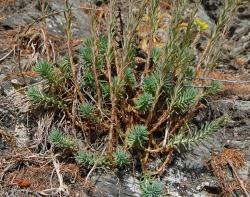- Taxon
- Gallery
Glabrous, perennial herb, forming loose mats; stems numerous, freely rooting at base, decumbent with ± erect apical parts to c. 10 cm high. Lvs alternate, sessile, crowded and imbricate along upturned part of sterile shoots and not concentrated near apex or forming rosettes, c. 7–17 × 1.5–2.5 mm and 1–1.5 mm thick, subcylindric and subterete with upper and lower surfaces convex and no obvious margins, ± glaucous, occasionally deep green; apex sharply acute or mucronulate. Infl. terminal, usually 15–30 cm high, with numerous leaflike bracts along main rachis, often > vegetative lvs, corymbose, usually 2.5–5 cm across, dense, with 3–5 forked branches. Fls numerous, with pedicels to 2 mm long, ± secund. Sepals slightly unequal, 2–3 mm long, triangular-ovate or oblong-ovate. Petals usually 5, ± patent, 5–6 × 1.7–2 mm, elliptic, narrowly or lanceolate-elliptic, yellow, ± obtuse. Stamens 4.5–6 mm long; filaments yellow; anthers yellowish. Carpels and styles greenish yellow. Scales ± rectangular (wider than long) to square. Follicles yellow, ± parallel. Seed c. 0.8–1 mm long, ± ellipsoid, longitudinally ribbed; ribs ± papillate.
[From: Webb et al. (1985) Flora of New Zealand. Volume 4 as Sedum reflexum L.]




